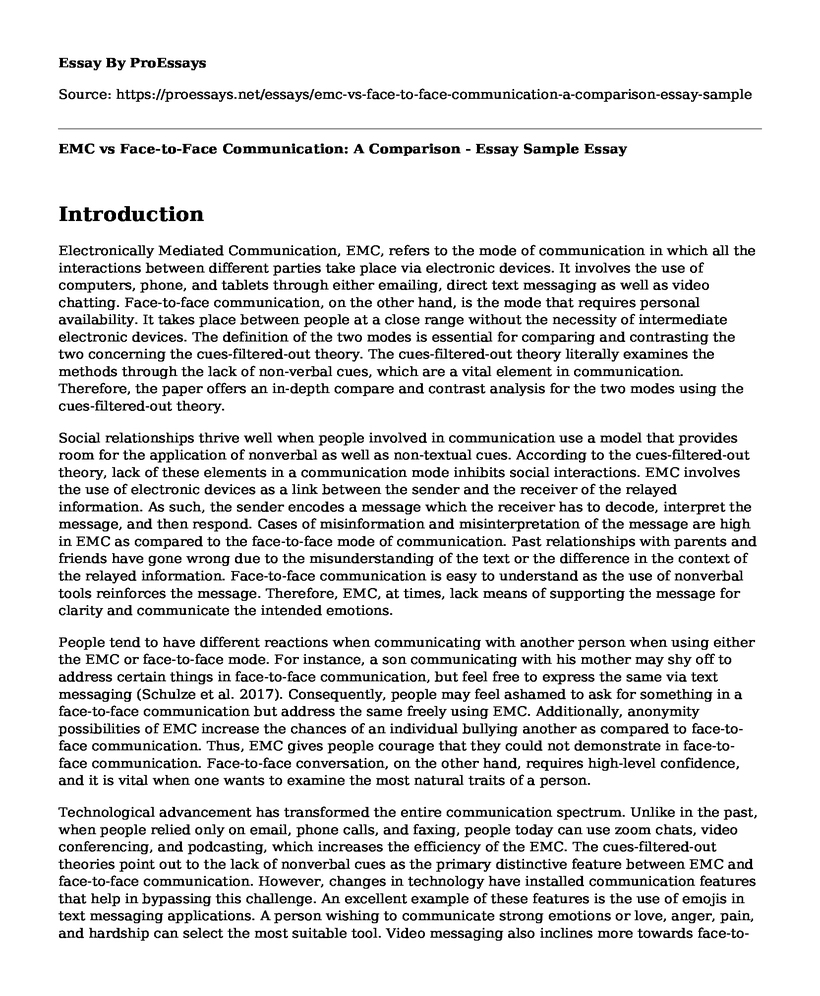Introduction
Electronically Mediated Communication, EMC, refers to the mode of communication in which all the interactions between different parties take place via electronic devices. It involves the use of computers, phone, and tablets through either emailing, direct text messaging as well as video chatting. Face-to-face communication, on the other hand, is the mode that requires personal availability. It takes place between people at a close range without the necessity of intermediate electronic devices. The definition of the two modes is essential for comparing and contrasting the two concerning the cues-filtered-out theory. The cues-filtered-out theory literally examines the methods through the lack of non-verbal cues, which are a vital element in communication. Therefore, the paper offers an in-depth compare and contrast analysis for the two modes using the cues-filtered-out theory.
Social relationships thrive well when people involved in communication use a model that provides room for the application of nonverbal as well as non-textual cues. According to the cues-filtered-out theory, lack of these elements in a communication mode inhibits social interactions. EMC involves the use of electronic devices as a link between the sender and the receiver of the relayed information. As such, the sender encodes a message which the receiver has to decode, interpret the message, and then respond. Cases of misinformation and misinterpretation of the message are high in EMC as compared to the face-to-face mode of communication. Past relationships with parents and friends have gone wrong due to the misunderstanding of the text or the difference in the context of the relayed information. Face-to-face communication is easy to understand as the use of nonverbal tools reinforces the message. Therefore, EMC, at times, lack means of supporting the message for clarity and communicate the intended emotions.
People tend to have different reactions when communicating with another person when using either the EMC or face-to-face mode. For instance, a son communicating with his mother may shy off to address certain things in face-to-face communication, but feel free to express the same via text messaging (Schulze et al. 2017). Consequently, people may feel ashamed to ask for something in a face-to-face communication but address the same freely using EMC. Additionally, anonymity possibilities of EMC increase the chances of an individual bullying another as compared to face-to-face communication. Thus, EMC gives people courage that they could not demonstrate in face-to-face communication. Face-to-face conversation, on the other hand, requires high-level confidence, and it is vital when one wants to examine the most natural traits of a person.
Technological advancement has transformed the entire communication spectrum. Unlike in the past, when people relied only on email, phone calls, and faxing, people today can use zoom chats, video conferencing, and podcasting, which increases the efficiency of the EMC. The cues-filtered-out theories point out to the lack of nonverbal cues as the primary distinctive feature between EMC and face-to-face communication. However, changes in technology have installed communication features that help in bypassing this challenge. An excellent example of these features is the use of emojis in text messaging applications. A person wishing to communicate strong emotions or love, anger, pain, and hardship can select the most suitable tool. Video messaging also inclines more towards face-to-face communication as people can use non-verbal cues. Therefore, development in technology has improved EMC. There is a minute defining feature between EMC and face-to-face communication based on non-verbal cues.
Conclusion
In a nutshell, EMC and face-to-face communication compare in that they both help in relaying information. The effectiveness of the information depends on both the sender and the receiver’s ability to encode and decode specific details in the communication. EMC, at some point, inhibits social interaction due to the lack of non-verbal aspects in communication. Instances of misinterpretation of information are high as a result of the lack of these non-textual tools in communication. Additionally, EMC creates an excellent opportunity for people to show their different personalities, something that is almost impossible in face-to-face communication. Nonetheless, technological advancement has revolutionized EMC through the development of tools that enhance communication and interactions, making it more of face-to-face communication.
References
Schulze, J., Schultze, M., West, S. G., & Krumm, S. (2017). The knowledge, skills, abilities, and other characteristics required for face-to-face versus computer-mediated communication: Similar or distinct constructs. Journal of Business and Psychology, 32(3), 283-300.
Cite this page
EMC vs Face-to-Face Communication: A Comparison - Essay Sample. (2023, Aug 28). Retrieved from https://proessays.net/essays/emc-vs-face-to-face-communication-a-comparison-essay-sample
If you are the original author of this essay and no longer wish to have it published on the ProEssays website, please click below to request its removal:
- Forced Marriages in Cambodia Paper Example
- Essay Sample on Developmental Psychology: Parenting Related to Development of Children
- Native Americans: Migration to Urban Areas Over Last 4 Decades - Essay Sample
- Essay Sample on Creating Safe Spaces: Exploring Eli Clare's Activism for Queer and Disabled People
- Essay on Community Policing: Building Relationships & Working Together for Public Safety
- Essay Example on 83-Year-Old Woman's Journey Through Late Adulthood: An Interview
- Australia: Individualism vs Collectivism in Business Context - Free Paper







